3.3 ROMANTIC COMPOSERS
Ludwig van Beethoven
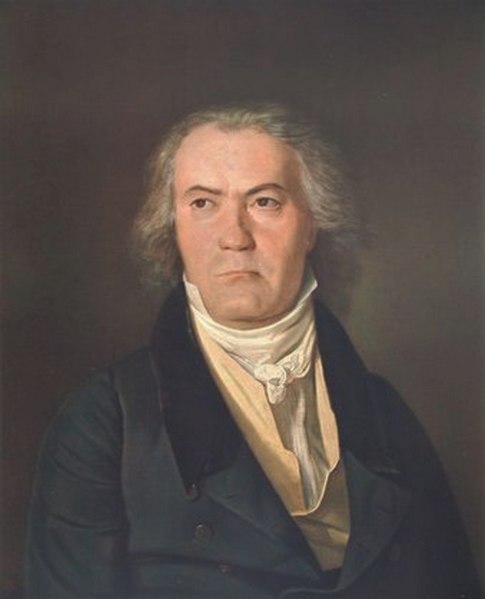
We looked at Beethoven (1770-1827) and his works in the Classical era, but as he matured his work became more of what fits the Romantic age. He was one of the most significant musical innovators of all time. He had the gift of invention and was able to take a musical fragment and stretch it and manipulate it into multi part masterpieces. In no earlier era could he have asserted his creative ego so defiantly, broken so decisively with the past and struck out in new directions with such independence. The spirit of the French Revolution had spread through Europe, stirring rebellion against the established authority. Crowns and heads toppled, traditions were shattered before the tidal wave of new ideas and the cry for political and intellectual freedom that stemmed from philosophers such as Rousseau and Voltaire. While Haydn and Mozart had created music that was balanced, with beautiful melodies and expressive restraint, Beethoven’s music was tortured. His early life with an alcoholic and abusive father drove him to escape his home town. His music was almost painful, just as his early youth had been. He learned to play a keyboard on a big organ and was sent to Vienna to learn more from Haydn and bring it back. Instead he began to write music and sell it in Vienna. He never returned to live at home again.
Beethoven’s music directly reflects his powerful, tortured personality. As he struggled with his deafness and his family problems, music was his outlet. In both life and music his heroic struggle resulted in victory over despair. His demand for perfection meant long and hard work. While Bach and Mozart seemed to be able to write effortlessly, Beethoven did not work fast and sometimes took several years to complete a single symphony. He carried his sketchbooks with him to write down ideas and to revise old ones.
Compare these two works, one by Mozart and one by Beethoven to hear what changed in the Romantic period. These are on YouTube, so skip and forgive the ads.
Mozart Piano Sonata in C major, written in 1788 10:11
If you receive an error with the link above, use the following link https://www.youtube.com/watch?v=I_AX4R-d29o
Beethoven’s Piano Sonata in C Minor Opus 13 written in 1795 17:05
If you receive an error with the link above, use the following link https://www.youtube.com/watch?v=qO8yfBLNVjU
The music of the Romantic era was imaginative, revolutionary, emotional, full of contrasts, and strongly individualistic. Composers found inspiration in literature, exotic locations, nature and the supernatural, and political and economic strife. Performers took their skills to higher levels of virtuosity and professionalism. The listening audience expanded beyond the aristocracy to include a wealthy middle class seeking entertainment and a place to spend their new money.
During the Romantic Age music was less predictable and seemingly more tolerant of disorder. There was greater tension and stronger climaxes which were achieved in different ways. Music became more dramatic and more emotional. Some composers drew upon the exoticism of ethnic elements, unusual instruments, melodies, and dance rhythm. Virtuosic performers and the developing sophistication of instruments inspired composers to write works no longer played solely by the amateur. Audiences were drawn to hear a renowned performer rather than the works of a certain composer.
We can divide Beethoven’s symphonies into three basic groups:
- The Viennese period from 1792-1802. He composed Symphonies 1 and 2 during this time. He used mostly Classical ideas with some innovations.
- The Heroic period from 1803-1815. Symphonies 3, 4,5,6,7, and 8 were written during this time. This is when Beethoven’s work begins to be more Romantic and his work is based less and less on the older Classical style.
- The Late period from 1820-1826. His Symphony no. 9 was written during this time and is very innovative.
During his early Viennese period Beethoven used mostly Classical forms and techniques, but he gave them new power and intensity. While he had written for the public in his early years in Vienna, during his middle years his work built up great tension and excitement are through syncopation and dissonance. The range of pitch and dynamics is greater than ever before. The contrasts of mood are more pronounced. Accents and climaxes seem titanic. Greater tension called for larger musical framework, so he expanded his forms. His scores are marked for tempo, dynamics, and expressiveness much clearer than any earlier composer. He wrote many works in the sonata form; however the development section is greatly expanded and is even more dramatic. The coda section is expanded and develops the theme even more. His third movement is a faster paced scherzo rather than a stately minuet. His works often have triumphant finales. He added the trombone, piccolo, and contrabassoon. The instruments in his orchestra were assigned difficult melodies. Even the timpani have a melody rather than just keeping the beat. Freedom and the right of the creative ego to assert itself unhampered were important to him. When Schuppanzigh, a famous violinist, and one of Beethoven’s longest and closest friends complained about the difficulty of his part, Beethoven is said to have remarked, “Do you believe that I think about your miserable fiddle when the muse strikes me?”2
One good example of his middle years is Symphony number 3, commonly called Eroic, or Herioic. In 1804, when Napoleon’s imperial ambitions became clear, Beethoven took hold of the title page of his Third Symphony and scratched the name Bonaparte out so violently that he made a hole in the paper. He later changed the work’s title to “Sinfonia Eroica, composta per festeggiare il sovvenire d’un grand’uom” (“Heroic Symphony, composed to celebrate the memory of a great man”), and he rededicated it to his patron, Prince Joseph Franz von Lobkowitz, at whose palace it was first performed.”3 Listen to this short excerpt and see if you can hear the Romantic struggles that Beethoven conveys.
Beethoven’s Eroica (Symphony No. 3) written in 1804 2:54
If you receive an error with the link above, use the following link https://www.youtube.com/watch?v=KEQIwm4eNoc
Some of Beethoven’s most important works were written in the last ten years of his life, when he was totally deaf. His 9th symphony fits in this category.
Beethoven’s 9th symphony, written between 1820 and 1826
If you receive an error with the link above, use the following link https://www.youtube.com/watch?v=rOjHhS5MtvA
Movement I: Allegro ma non troppo un poco maestoso: 1:50
Movement II: Molto vivace: 19:50
Movement III: Adagio molto e cantabile: 35:50
Movement IV: Finale: 52:13
Beethoven died in 1827, at the age of 56 probably from complications of tuberculosis. The funeral procession was attended by an estimated 20,000 of his friends and followers in Vienna.
Another aspect of Romantic music is “nationalism”. This means devotion to the interests or culture of a particular nation, or aspirations for national independence in a country under foreign domination. During the 19th century Europeans felt that their homelands merited loyalty and self-sacrifice. These feelings were awakened during the American and French Revolutions. When Napoleon invaded neighboring countries, military resistance to his armies aroused the citizen’s sense of national identity. Common bonds of language, culture, and history were strengthened, since now soldiers were drawn from the common citizen rather than hired mercenaries as in the past. Nationalism led to the unification of countries that had previously been divided into tiny states, like Germany and Italy. It also spurred revolts in countries under foreign domination such as Poland and Bohemia.
Nationalism was a potent cultural movement because of its use of the vernacular language in textbooks, newspapers, and official documents. In every land the “national spirit” was felt to reside in the “folk” and the peasantry. The national past became the subject of intense historical investigation, and there was new enthusiasm for folk songs, dances, legends and fairy tales. Musical nationalism was expressed when composers deliberately created music with a specific national identity. They created original melodies with a folk flavor. Composers wrote operas and program music inspired by the history and landscapes of their native lands. These works bear titles like “Russian Easter”, “Finlandia”, and “Slavonic Dances.” A composer can create music that sounds French, Russian, or Italian when its rhythm, tone color, texture and melody spring from national tradition. During revolutionary times, musical compositions symbolized nationalist yearnings and sometimes stirred audiences to violent political action. The Italian composer Verdi deliberately chose librettos, which are the words of an opera, that fanned public hatred for the Austrian overlords. Much the same thing happened in Prague when the Nazi’s banned the performance of Smetana’s Moldau, and in Russia in 2022 when Russia invaded Ukraine and the Ukrainian national anthem was banned in Russia. Early in the 19th century composers like Chopin transformed Polish dances into great art. After about 1860, groups or “schools” of composers consciously declared their musical independence and established national styles. This included artists such as Smetana, Dvorak, Rimsky-Korsakov, Grieg, and Sibelius.
Bedrich Smetana (1824-1884)
Bedrich Smetana was the founder of Czech national music. He grew up when Bohemia was under domination by the Austrian government. The official language was German, not Czech. Smetana probably participated in the revolutions of 1848 as a member of the Citizen Corps. The insurrection was a failure and restrictions were tightened even further. The rebels were imprisoned and censorship was increased. He moved to Sweden and returned in 1862 when the restrictions were relaxed slightly. Political prisoners were released, Czech language newspapers were established, and Czech theaters for drama and opera were opened. At the age of 50 he became completely deaf. Many of his finest works were written after this. He spent his last ten years in acute physical and mental torment caused by dementia and syphilis. His family, unable to care for him, placed him in the Katerinky Lunatic Asylum in Prague where he died at the age of sixty.
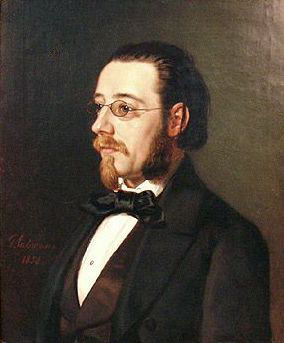
Between 1874 and 1879 be wrote a series of six symphonic poems glorifying Bohemian history and legend, the fertile Czech countryside, and peasant songs and dances. It was written shortly after he became deaf. It gives no hint of his pain and anguish, but instead is an excellent example of program music and shows his love of his homeland. The complete work is called Ma Vlast or My Fatherland and “The Moldau” is one of the six symphonic poems, which describes the course of the Vltava River from the source to its junction with the Elbe. Take the time to listen to this work and follow the progress through forests and meadows of Smetana’s homeland. The link below is one example on YouTube. Skip the commercials.
The Moldau (Vltava) by Bedrich Smetana 14:40
If you receive an error with the link above, use the following link https://www.youtube.com/watch?v=l6kqu2mk-Kw
It begins with two small springs, depicted by flutes playing running notes
The river becomes bigger and violins play. The “song-like” river theme recurs later in the work
The forest hunt, played by French horns and trumpets, hunting calls, running notes of the animals in flight
A peasant wedding is a polka played on strings
The dance of water nymphs in the moonlight played by woodwinds and flutes
The river theme plays again with violins and running notes
The rapids of St. Johann played by the full orchestra and percussion
The ancient castle of Vysehrad is represented by the brass section and the woodwinds
And finally the river disappears into the Elbe
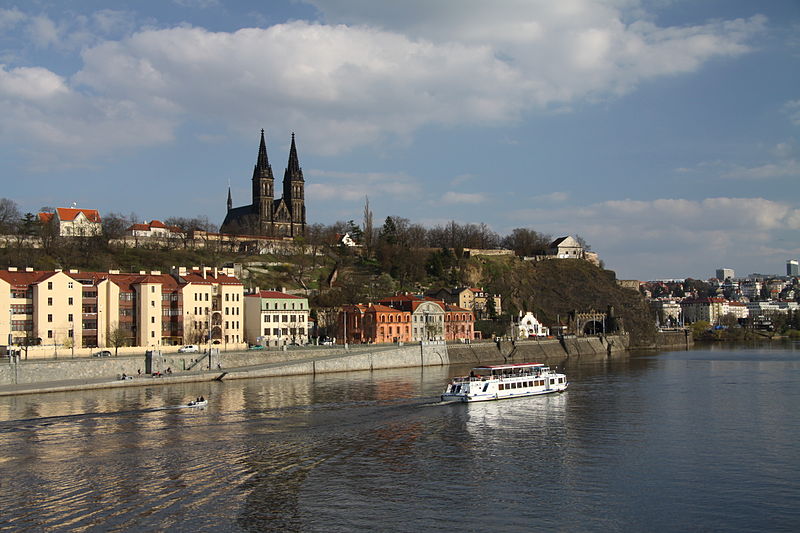
Frederic Chopin (1810-1849)
Fredric Chopin was born in Poland, but lived most of his life in Paris. He began piano lessons at age seven and wrote his first musical piece, Polanaise in G Minor that year. He was known as a child prodigy from the age of eight. Chopin was not well liked in the large, public music halls because he had such a light touch. He wrote almost exclusively for the piano but wrote a few orchestral works. He wrote nocturnes, etudes, preludes, waltzes, polonaises, mazurkas, fantasies and the berceuse and barcarole.
Definitions of the types of music written by Chopin:
- Barcarole: a boating song patterned after the songs sung by gondoliers in Venice
- Berceuse: a lullaby
- Etude: a study designed to help students master specific technical difficulties
- Fantasie: a musical form that allowed improvisation and did not require the adherence to a specific form
- Mazurka: a traditional Polish dance
- Nocturne: a work based on a quiet nighttime mood
- Prelude: Chopin’s preludes are short, self contained works written to convey a specific mood
- Polonaises: slow Polish dance in triple meter, used as a promenade for couples
- Waltz: a dance in triple time. Originally written to be danced to, but was eventually included in larger works
His music was well liked by the critics, but was banned in his native Poland because its patriotic spirit stirred the masses. Chopin taught music stressing the flexible wrist and arm, new fingerings, and beautiful tone. The portrait of Chopin below was painted by 16year old Maria Wodzinska, with whom Chopin had an affair but never married. When the revolution began in Paris in 1848 he lost most of his patronage. Chopin had a ten year affair with the novelist George Sand and struggled with tuberculosis nearly all of his life. He died of TB in October 1849 at the age of 39. His sister had his heart removed by their physician and she carried it with her in a jar back to Poland where it was buried. Chopin’s body was buried in Paris.
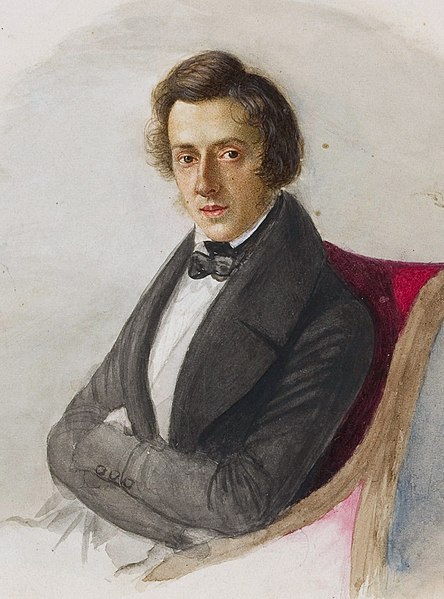
No one could make the piano sing like Chopin. He has often been called the poet of the piano. Many of his most poetic effects come from the sensitive exploitation of the damper “loud” pedal. The pedal connects widely spaced tones in the left hand accompaniment. Chopin’s compositions allow a pianist to heighten expression by slight speeding up or slowing down the tempo, which is called rubato. This means that the person playing the music may stretch some beats or phrases or shorten others, and the choice may be at the performer’s discretion or it may be marked on the score. This option lends an improvisatory quality to his music and is part of what makes it Romantic rather than classical.
Etude in C Minor, opus 10, No. 12, Revolutionary, written in 1831 2:50
If you cannot view the video above, use this link https://www.youtube.com/watch?v=s2-t4RsT_l8
This Etude or study was probably inspired by the Russian takeover of Warsaw in 1831. This work was designed to help a performer master speed and endurance in the left hand, which must play rapid passages throughout. It begins with a dramatic outburst of downward rushing passages which lead to the main melody. It is played in octaves in the right had. After a climax, tension momentarily subsides, and then a torrential passage sweeps downward to the powerful closing chords.
Polonaise in A Flat Major, opus 53, written in 1842 6:26
If you receive an error with the link above, use the following link https://www.youtube.com/watch?v=8QT7ITv9Ecs
The Polonaise in A Flat Major evokes the ancient splendor of the Polish people. The form is ABA with a coda. The middle section is a majestic march-like melody accompanied by relentlessly repeated rapid octaves in the left hand. This section tests a pianist’s strength and endurance. Powerful crescendos bring mounting excitement. Gradually the mood relaxes to prepare for the final return of the heroic main theme.
Peter Ilyich Tchaikovsky (1840-1893)

“Peter Ilyich Tchaikovsky, was a Russian composer whose works included symphonies, concertos, operas, ballets, chamber music, and a choral setting of the Russian Orthodox Divine Liturgy. Some of these are among the most popular theatrical music in the classical repertoire. He was the first Russian composer whose music made a lasting impression internationally, which he bolstered with appearances as a guest conductor later in his career in Europe and the United States. One of these appearances was at the inaugural concert of Carnegie Hall in New York City in 1891.
Despite his many popular successes, Tchaikovsky’s life was punctuated by personal crises and depression. Contributory factors included his leaving his mother for boarding school, his mother’s early death, as well as that of his close friend and colleague Nikolai Rubinstein, and the collapse of the one enduring relationship of his adult life, his 13-year association with the wealthy widow Nadezhda von Meck. His homosexuality, which he kept private, has traditionally also been considered a major factor, though some musicologists now downplay its importance. His sudden death at the age of 53 is generally ascribed to cholera; but there is an ongoing debate as to whether his death was accidental or self-inflicted.
While his music has remained popular among audiences, critical opinions were initially mixed. Some Russians did not feel it was sufficiently representative of native musical values and were suspicious that Europeans accepted it for its Western elements. In apparent reinforcement of the latter claim, some Europeans lauded Tchaikovsky for offering music more substantive than base exoticism, and thus transcending stereotypes of Russian classical music. Tchaikovsky’s music was dismissed as “lacking in elevated thought,” according to longtime New York Times music critic Harold C. Schonberg, and its formal workings were derided as deficient for not following Western principles stringently.”8
Tchaikovsky was not a child prodigy. His father sent him to school to learn to be a government clerk but he wanted to learn more about music. In 1862 when he was 22, the St Petersburg Conservatory opened and he began attending. He was a teaching assistant in some of the classes until 1877when the wealthy Nadezhda von Meck, began to support him. Her support enabled him to stop teaching at the conservatory. This lasted for thirteen years at a base pay of six thousand rubles a year plus bonuses. She agreed to support him as long as they did not have to meet each other. They only met once, accidentally, but had a stormy relationship by mail, exchanging more than a thousand letters. She dropped him in 1890
He was very sensitive and emotional, and so was his music. He had periods of self doubt and depression. He drank, smoked and gambled too much, and he had stage fright. He was the first Russian composer to become well known.
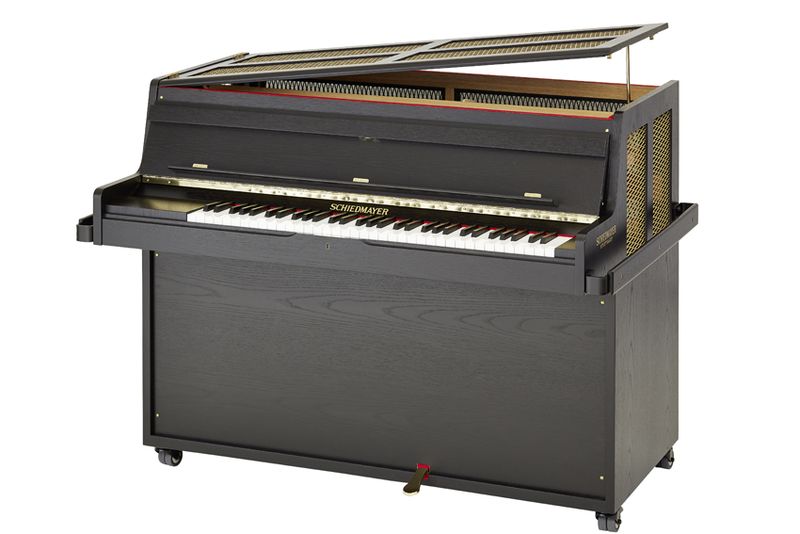
One of the favorite works written by Tchaikovsky is The Nutcracker, written in 1892. It is based on the story “The Nutcracker and the Mouse King”, written by E.T.A. Hoffmann. It is a Christmas story about a young girl who receives a nutcracker, and falls asleep with it under the Christmas tree. She then shrinks to the size of the mice and takes a magical trip to visit a Mouse King, a prince, the Land of Sweets, and a festival inside a Candy Castle. While writing the Nutcracker Tchaikovsky discovered the celeste as he traveled from the United States to Paris in 1891. It looks like a piano, but the hammers strike metal tubes and sound ethereal and otherworldly. He determined that the sound was what he needed for the Dance of the Sugar Plum Fairy so he added it to his orchestral requirements. The link below is the Dance of the Sugar Plum Fairy from the Nutcracker.
Dance of the Sugar Plum Fairy 3:31
If you receive an error with the link above, use the following link https://www.youtube.com/watch?v=Wz_f9B4pPtg
The 1812 Overture is one of the most popular and recognizable pieces of music ever written, although the composer himself dismissed it as “very loud and noisy and completely without artistic merit, obviously written without warmth or love.”10 The overture was written by a Tchaikovsky, a Russian to commemorate Tsar Alexander I’s victory over Napoleon. The Battle of Borodino was a key battle of the Napoleonic wars, and its bloodiest. Seventy thousand troops perished. Napoleon won the battle, but used the win to launch an attack on Moscow. He waited for more than a month and Moscow did not surrender. Instead the cold weather and lack of food caused the French to retreat and the war was lost. Listen to this work and you will hear Russian folk songs “battle with” the French national anthem, The Marseillaise. It also includes cannons, a Russian Orthodox hymn to celebrate the opening of the Cathedral of Christ the Saviour, and was also intended to celebrate the 25th anniversary of Alexander II’s coronation. Tchaikovsky did not like it because it was more about theatrical spectacle and he thought it did not show his imaginative whimsy and his ability to compose ballet. It is often used to celebrate the 4th of July in the United States.
1812 Overture 15:08
If you receive an error with the link above, use the following link https://www.youtube.com/watch?v=VbxgYlcNxE8
Tchaikovsky’s work comes at the end of the Romantic age. His troubled personal life can be heard in his music. His collective body of work is 169 pieces including 7 symphonies,11 operas, 3 ballets, 4 concertos, 4 cantatas and more than100 songs.
Franz Peter Schubert (1797-1828)
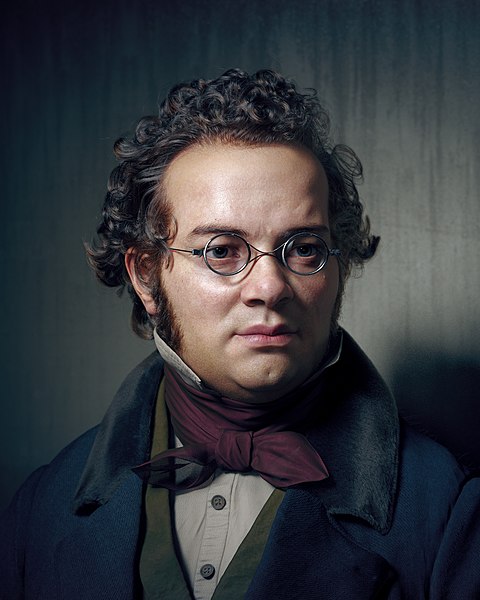
Franz Peter Schubert was born near Vienna, on 31 January 1797. His father, Franz Theodor Schubert, the son of a Moravian peasant, was a parish schoolmaster; his mother, Elisabeth (Vietz), was the daughter of a Silesian master locksmith and had been a housemaid for a Viennese family before her marriage. Of Franz Theodor’s fourteen children, nine died in infancy and only five survived. Their father was a well-known teacher, and his school had numerous students in attendance. Although his father was not recognized or even formally trained as a musician, he was able to pass on certain musical basics to his gifted son.
At the age of six, Franz began to receive regular instruction from his father and a year later was enrolled at his father’s school. His formal musical education also started around the same time. His father taught him basic violin technique, and his brother Ignaz gave him piano lessons. At the age of seven, he was given his first lessons outside the family by Michael Holzer, organist and choirmaster of the local parish church in Lichtental, lessons which may have largely consisted of conversations and expressions of admiration. The boy seemed to gain more from his acquaintance with a friendly joiner’s apprentice who used to take him to a neighboring pianoforte warehouse where he could practice on better instruments. He also played viola in the family string quartet, with brothers Ferdinand and Ignaz on first and second violin and his father on the violoncello. He wrote his earliest string quartets for this ensemble.
Young Schubert first came to the attention of Antonio Salieri, who was then Vienna’s leading musical authority. In 1808 he became a pupil at the Stadtkonvikt (Imperial Seminary) through a choir scholarship where he was introduced to the overtures and symphonies of Mozart and the symphonies of Joseph and Michael Haydn. For a time he taught the youngest students at his father’s school. He wrote religious works for friends and acquaintances and eventually began to gain more notoriety in Vienna and abroad. In 1818 he was a private music teacher and again taught at his father’s school.
In 1820 he and some of his friends were arrested by Austrian police who, in the aftermath of the French Revolution and the Napoleonic Wars were on their guard against suspicious gatherings. Schubert was severely reprimanded but not imprisoned. His works of 1819 and 20 began to show his more mature style. He began to write larger works that were intended for the public, rather than for the amateur orchestra in his father’s circle of friends. In 1821 Vogl performed the song “Der Erlking” at a concert and it was well received. He also began writing operas and other stage projects. In 1824 the first symptoms of syphilis showed up, and they bothered him until he died at the young age of 31. Shubert wrote over 1,500 works in his remarkably short career. Over 600 of these are songs for solo voice and piano. He also composed a considerable number of secular works for two or more voices, namely part songs, choruses and cantatas. He completed eight orchestral overtures and seven complete symphonies, in addition to fragments of six others. While he composed no concertos, he did write three concertante works for violin and orchestra. There is a large body of music for solo piano, including fourteen complete sonatas, numerous miscellaneous works and many short dances. There is also a relatively large set of works for piano duet. There are over fifty chamber works, including some fragmentary works. His sacred output includes seven masses, one oratorio and one requiem, among other mass movements and numerous smaller compositions. He completed only eleven of his twenty stage works.
Schubert left many works incomplete. He is known for his experimentation in many types of work and was adventurous in his sense of modulation from one key to another and his unusual choices of instrumentation. His most important contribution was in the creation of the leid, plural leider, of which he wrote more than 600. One example of a leid is The Erlkonig, (The Erlking), written in 1782 by Johann Wolfgang von Goethe. It is based on the legend that whoever is touched by the King of the Elves must die. In the poem there are four characters: the narrator, the father, the child and the seductive Elf. Schubert wrote music to accompany Goethe’s text. It is usually sung by a single performer who changes his voice to portray all four characters. Schubert is one of several composers who wrote music to tell this story. Listen to one of the performances of the Erlking by Schubert and see if you can determine what makes it a Romantic work of art.12
The ErlkingThe Erlking with English subtitles 5:18
If you receive an error with the link above, use the following link https://www.youtube.com/watch?v=ao8DGnCBApw
Narrator:
Who rides so late through night and wind?
It is the father with his child.
He holds the boy firmly in his arm.
He clasps him tight, he keeps him warm.
Father:
“My son, why hide your face in fear?”
Son:
“Father, do you not see the Erlking?
The Erlking with crown and tail?”
Father:
“My son, it is only a streak of mist.”
Erlking:
“You sweet child, come, go with me!
Such pleasant games I’ll play with you.
Many bright flowers bloom along the shore,
My mother has many a robe of gold.”
Son:
“Oh father, father, do you not hear
What the Erlking gently promises me?”
Father:
“Be calm, my child, stay calm;
It is only the wind among the dead leaves.”
Erlking:
“Lovely boy, will you come with me?
My daughters will serve you well.
My daughters keep nightly revels,
They’ll sing and dance and rock you to sleep.
They’ll sing and dance and rock you to sleep.”
Son:
“Oh father, father, do you not see
The Erlking’s daughters in the darkness?”
Father:
“My son, my son, I see quite clearly
The old willow trees gleaming gray.”
Erlking:
“I love you, your beauty charms me,
And if you’re not willing, I’ll use force!”
Son:
“Oh father, father, he seizes me!
The Erlking has done me harm!”
Narrator:
The father shudders, he rides swiftly,
Holding fast the moaning child.
He reaches home with pain and dread:
In his arms the child lay dead!

